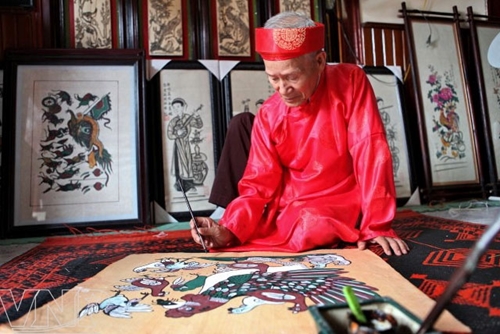The dossiers are being compiled by the Vietnam National Institute of Culture and Art Studies under the Ministry of Culture, Sports and Tourism in a bid to secure UNESCO recognition as intangible cultural heritage of emergency protection.
    |
 |
|
An artisan finishing a Dong Ho painting |
If recognized, this traditional art could be revived and its value promoted.
Vietnam has been submitting dossiers on Then singing of the Tay, Nung and Thai ethnic groups, Xoe dance of the Thai ethnic group, and pottery making of the Cham ethnic people to seek UNESCO recognition. Dong Ho folk painting has been recognized as national intangible cultural heritage.
According to statistics, there are only three artisans and 20 practitioners in this job, and only two old people are able to teach this kind of art.
It is a genre of Vietnamese woodcut paintings originating from Dong Ho village in Bac Ninh province. Using the traditional diep paper and colors derived from nature, craftsmen print Dong Ho pictures of different themes from good luck wishes and historical figures to everyday activities and folk allegories.
It is considered a fine reflection of the traditional aesthetic value, social philosophies and humanitarian desires as spring approaches.
Elements of everyday life are well integrated in Dong Ho painting so that it can be used to express the thoughts and wishes of people.
Because Dong Ho paintings are mainly bought and displayed on the occasion of Tet, the Lunar New Year, contents of pictures are often humorous, optimist with many bright and powerful colors like red, yellow or white. Some Dong Ho paintings became famous for their interesting themes.
According to locals, the making of Dong Ho painting has dated back to the 11th century during the reign of the Ly Dynasty; while researchers propose that craftsmen began to print pictures in Dong Ho village during the rule of the Le Dynasty in the 17th century.
Source: VNA